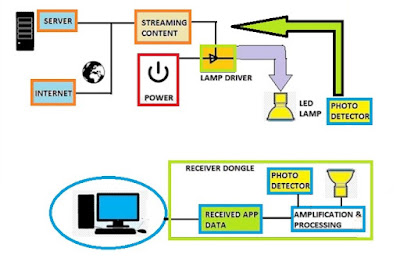Due to the increasing
demand for wireless data communication, the available radio spectrum below 10
GHz (cm-wave communication) has become insufficient. The wireless communication
industry has responded to this challenge by considering the radio spectrum above
10 GHz (mm-wave communication). The answer to increasing
frequency congestion as Internet usage continues to rise across the world is
provided by Light-Fidelity (Li-Fi). It’s a very exciting technology that has
been on our radar since Professor Harald Hass gave a TED talk on the
topic back in 2011.
Light-Fidelity (Li-Fi) is a continuation of the
trend to move to higher frequencies in the electromagnetic spectrum. Data
is transmitted by modulating the intensity of LED light at nanosecond
intervals, too quick to be detected by the human eye. It uses visible
light between 400 and 800 THz (780–375 nm) to transmit binary data in the form
of light pulses. Actually how it works- Li-Fi uses common household LED
(light emitting diodes) lightbulbs to enable data transfer, boasting speeds of
up to 224 gigabits per second. Standard LED lightbulbs use a constant
current, which emits a constant stream of photons perceived by us as visible
light. LEDs are semiconductors so the current and output can be modulated
at high speeds, which is picked up via a photodetector device. The optical
output is then converted back into an electrical current, which is processed
and sent to your device as data. Li-Fi depends on your device being within
range of the light being transmitted by your Li-Fi bulb.
Why we use LEDs specifically? Its
because LED bulbs use 85% less energy than incandescent bulbs and last up
to 20 times longer. LED lights are natural beam-formers, which makes it easier
to create separate uplink and downlink channels, which essentially means more
secure internet browsing. Using
LEDs as it has both reduced the light consumption as well as heat dissemination.
Besides energy-efficiency
of LEDs, there is an added benefit for LiFi cellular deployment in that it can
build on existing lighting infrastructures.
 Due to its shorter range, Li-Fi is more secure
than Wi-Fi. Light's inability to penetrate walls makes it potentially secured. Li-Fi lowers the possibility of external sniff
and hacking attempts. The visible light spectrum has 10,000 times more bandwidth
than radio waves spectrum. Plus, it’s unlicensed and free to use.
Due to its shorter range, Li-Fi is more secure
than Wi-Fi. Light's inability to penetrate walls makes it potentially secured. Li-Fi lowers the possibility of external sniff
and hacking attempts. The visible light spectrum has 10,000 times more bandwidth
than radio waves spectrum. Plus, it’s unlicensed and free to use.
Data can be transmitted
over the light spectrum, this makes Li-Fi a form of optical wireless
communication. Li-Fi uses infra-red and ultra-violet (visible light) waves to
communicate data. Infra-red and ultra-violet spectrums can carry more
information than radio frequency waves. This is why Li-Fi can achieve greater
speeds than Wi-Fi. Li-fi can deliver internet access 100 times faster than
traditional wi-fi, offering speeds of up to 1Gbps (gigabit per second). I also believe that the high speed and the large data
density could totally change the way we
watch television and also will have great impact on satellite communications.
Benefit of using Li-Fi technology in hospitals,
nuclear power plants and aircraft cabins is that it does not cause
electromagnetic interference. Li-Fi technology will allow high data
connectivity for each air craft passenger at all times. The reduction in
cabling requirement also means a lighter aircraft. It is also used in
cellular and underwater communications as light can penetrate for large
distances unlike radio waves which get absorbed in water,
preventing underwater radio communications.
Since
new generation vehicles are coming with LED headlights and taillights and street
lights, signage and traffic lights are switching to energy-efficient LEDs. So, Li-Fi technology
can be easily used for vehicle-to-vehicle and vehicle-to-roadside sensor
communications for road safety and traffic management system.
On a larger scale, lasers can be used to transmit high
rates of data between satellites in space or to dishes on
the ground. Such systems can allow military or telecoms
information to pass between two towers or from space to
the earth.
Limitations
- A major hurdle
is that the connection will be lost if a user leaves the room. To have
a continuous Li-Fi network inside our house, we will need
lightbulbs in every room to have seamless connectivity.
- Another
major issue is that Li-Fi does not work outdoors, meaning that public
Li-Fi will not be able to replace public Wi-Fi networks any time
soon. When it comes to
outdoor use-cases, interference from sunlight prevents one from employing
Li-Fi solutions.
- Though Li-Fi is not unidirectional, i.e.
it can both transmit and receive data, LEDs can currently only be used to
transmit data due to feasibility and cost issues involved,
as specially designed ASIC receiver or SoC receivers are required for uplink transmission.
- Opaque obstacles on pathways can affect data transmission
- One of the biggest drawbacks of Li-Fi is that it requires light to be switched on all the time to deliver connectivity.
Li-Fi technology made
its way out of laboratories to live trials in 2015. LiFi is a 5G technology
which will unlock the Internet-of-Things and in the future, using light bulb as
your wireless hotspot. With faster connectivity and data transmission,
Li-Fi promises to be cheaper and more power efficient than existing
wireless technologies. It should be remembered that Li-Fi probably won’t replace Wi-Fi altogether,
rather, both the technologies will be used simultaneously for a cleaner,
greener, brighter tomorrow.



1 comment:
I want to buy Air Charter Services
Post a Comment